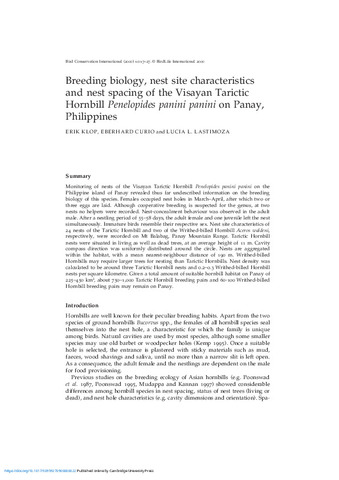| dc.contributor.author | Klop, Erik | |
| dc.contributor.author | Curio, Eberhard | |
| dc.contributor.author | Lastimoza, Lucia L. | |
| dc.coverage.spatial | Mt Balabag | en |
| dc.coverage.spatial | Sibaliw | en |
| dc.coverage.spatial | Panay | en |
| dc.date.accessioned | 2022-03-23T06:28:57Z | |
| dc.date.available | 2022-03-23T06:28:57Z | |
| dc.date.issued | 2000-03 | |
| dc.identifier.citation | Klop, E., Curio, E., & Lastimoza, L. L. (2000). Breeding biology, nest site characteristics and nest spacing of the Visayan tarictic hornbill Penelopides panini panini on Panay, Philippines. Bird Conservation International, 10(1), 17–27. | en |
| dc.identifier.issn | 0959-2709 | |
| dc.identifier.uri | http://repository.wvsu.edu.ph/handle/123456789/88 | |
| dc.description.abstract | Monitoring of nests of the Visayan Tarictic Hornbill Penelopides panini panini on the Philippine island of Panay revealed thus far undescribed information on the breeding biology of this species. Females occupied nest holes in March–April, after which two or three eggs are laid. Although cooperative breeding is suspected for the genus, at two nests no helpers were recorded. Nest-concealment behaviour was observed in the adult male. After a nestling period of 55–58 days, the adult female and one juvenile left the nest simultaneously. Immature birds resemble their respective sex. Nest site characteristics of 24 nests of the Tarictic Hornbill and two of the Writhed-billed Hornbill Aceros waldeni, respectively, were recorded on Mt Balabag, Panay Mountain Range. Tarictic Hornbill nests were situated in living as well as dead trees, at an average height of 11 m. Cavity compass direction was uniformly distributed around the circle. Nests are aggregated within the habitat, with a mean nearest-neighbour distance of 190 m. Writhed-billed Hornbills may require larger trees for nesting than Tarictic Hornbills. Nest density was calculated to be around three Tarictic Hornbill nests and 0.2–0.3 Writhed-billed Hornbill nests per square kilometre. Given a total amount of suitable hornbill habitat on Panay of 225–450 km<sup>2</sup>, about 750–1,000 Tarictic Hornbill breeding pairs and 60-100 Writhed-billed Hornbill breeding pairs may remain on Panay. | en |
| dc.description.sponsorship | We would like to thank the members of the PESCP teams in Hamtang and Sibaliw, especially N. Arsenio, M. Ballhaus, J. Berdin, T. Dalumpines, R. Ebon, B. Gonzales, N. Jarn˜o, G. Meier, S. Peters, Y. de Soye and B. Tacud, for all their support. We also thank the people of Nawili for their overwhelming hospitality.
Further support came from the Frankfurt Zoological Society, the Andreas-StihlStiftung, the EU, the German Ornithologists’ Society, the Ministry of Science and Research of the Land North Rhine Westfalia, Prof. Dr Dr mult. h.c. Ernst Mayr, Cambridge, MA, and Mr Claus Sudhoff (Cavite). The Protected Areas and Wildife Bureau and the Land Evaluation Party (coordinator Mr Henry M. Balmores) of the DENR (Director Wilfrido S. Pollisco, Region VI RED R. Geollegue and RTD R. Pangahas) and West Visayas State University (President Dr Bernabe B. Cocjin and the dean of the College of Agriculture and Forestry Dr Eleodoro L. Alicante) provided advice and support throughout. To all these persons and organizations we are immensely grateful. This paper is publication No. 16 of the Philippine Endemic Species Conservation Project (PESCP) of the Frankfurt Zoological Society. | en |
| dc.language.iso | en | en |
| dc.publisher | Cambridge University Press | en |
| dc.publisher | BirdLife International | |
| dc.relation.uri | | en |
| dc.subject | Visayan Tarictic Hornbill | en |
| dc.subject.lcsh | Hornbills | en |
| dc.subject.lcsh | Reproductive biology | en |
| dc.subject.lcsh | Birds--Nests | en |
| dc.subject.lcsh | Animal breeding | en |
| dc.title | Breeding biology, nest site characteristics and nest spacing of the Visayan tarictic hornbill Penelopides panini panini on Panay, Philippines | en |
| dc.type | Article | en |
| dcterms.accessRights | Open access | en |
| dc.citation.journaltitle | Bird Conservation International | en |
| dc.citation.volume | 10 | en |
| dc.citation.issue | 1 | en |
| dc.citation.firstpage | 17 | en |
| dc.citation.lastpage | 27 | en |
| local.subject.scientificname | Penelopides panini | en |
| local.subject.scientificname | Penelopides panini panini | en |
| local.subject.scientificname | Aceros waldeni | en |
| local.subject.scientificname | Rhabdotorrhinus waldeni | en |
| dc.identifier.essn | 1474-0001 | |
| dc.identifier.doi | 10.1017/S0959270900000022 | |
| local.isIndexedBy | ISI | en |
| local.isIndexedBy | Scopus | en |
| local.subject.agrovoc | reproductive behaviour | en |
| local.subject.agrovoc | nesting | en |
| local.subject.agrovoc | bird nests | en |


